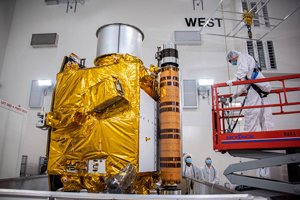NASA’s Double Asteroid Redirection Test (DART) Mission
by Stuart Brookes and Richard Oakley
Press coverage of the mission.
https://www.independent.co.uk/space/nasa-dart-mission-live-asteroid-b2175263.html
What you Need to Know
- The purpose of the mission is to test the world’s first planetary defence system to determine how prepared NASA is to prevent the collision of an asteroid with Earth.
- NASA’s DART mission is designed to deliberately crash a spacecraft into a space object to see if the space object’s orbit and trajectory can be altered.
- The DART spacecraft which was approximately two metres tall, one metre wide and a metre deep and has two rectangular solar arrays, was targeted at an asteroid called Dimorphos.
- Dimorphos is the size of a football stadium, the spacecraft was planned to collide with it and self-destructed in the process, at around 23.20pm GMT on the 27th September 2022 (0.20 BST 28th September), some 6.8 million miles from Earth
- The mission’s purpose was to test a spacecraft’s ability to alter an asteroid’s trajectory using its own kinetic energy, by impacting the object at sufficient speed to nudge it away from what could be a potential collision situation with Earth.
- If successful this mission will be the first time that humanity has changed the motion of an asteroid, or any celestial body.
- The space craft was designed to collide with the asteroid and in so doing its impact will alter the asteroid’s speed by about 1mm/sec. The space craft was travelling at a speed of 14,000 mph at its point of impact. Using Newtonian physics, the force of the space craft travelling at high speed combined with its mass will alter the speed and trajectory of the much higher mass asteroid.
- For the test the smaller Dimorphos, which orbits around the larger asteroid Didymos, and which poses no threat to Earth, is approximately 150m across.
- The mission launched on 23rd November 2021, using a Falcon 9 launch rocket, is a demonstration technology to see if this method of planetary protection has any merit.
- Following the impact NASA is carrying out calculations to decide whether this methodology has been successful or whether they need to go back to the drawing board.
DART is part of a wider planetary protection system:
Synopsis
DART is the first mission dedicated to investigating and demonstrating a method of asteroid deflection by changing an asteroid’s motion using kinetic impact. This method has DART deliberately collide with a target asteroid (Dimorphos)—which poses no threat to Earth— in order to change its speed and path. DART’s target is the binary, near-Earth asteroid system Didymos, composed of a 780m diameter “Didymos” and a smaller, approximately 160m -sized “Dimorphos”, which orbits Didymos. DART will impact Dimorphos to change its orbit within the binary system, the DART Investigation Team will compare the results from the DART’s kinetic impact with Dimorphos against detailed computer simulations of kinetic impacts on asteroids. By comparison of the actual and predicted effects NASA will determine the effectiveness of this method and assess how best to apply the results to future planetary defensive arrangements.
Deliverables
DART’s Mission Objectives are:
- To demonstrate the feasibility of a kinetic impact with Dimorphos.
- To measure the change to the binary orbital period of Dimorphos.
- Then by using earth sited telescope observations already measured of Dimorphos’ orbit before the impact and the change to the orbit after impact.
- Identify if there are any effects of the impact and resulting ejecta on Dimorphos.
Search
The current United States congressionally directed objective of the Near Earth Orbit (NEO) Observations Program is to find, track, and characterize at least 90 percent of the predicted number of NEOs that are 140 meters and larger in size and to characterise a subset representative of the entire population. Objects of this size and above pose a risk to Earth owing to the level of destruction an impact would cause, and this should continue to be the focus of global search efforts. While no known asteroid larger than 140 meters in size has a significant chance of impacting Earth for the next 100 years, less than half of the estimated 25,000 NEOs that are 140 meters and larger in size have yet been found.
Seek and Observe
The NEO Observations Program sponsors projects that make use of telescopes around the world to search for NEOs, track them across the sky to determine their orbits, and gain information on their sizes, shapes, and composition.
The Minor Planet Center (MPC) is the internationally agreed public archive of small-body orbit data submitted by observers from around the world. The MPC notifies observers worldwide about NEO discoveries so that further follow-up observations can be collected for identification and orbit computation. The MPC is sanctioned by the International Astronomical Union, is supported by NASA’s Planetary Data System Small Bodies Node. and specifically by the PDCO which is a part of this organisation.
Know your Orbit
The Center for Near-Earth Object Studies (CNEOS) computes high-precision orbit paths for NEOs from positions reported to the Minor Planet Center. CNEOS both computes orbits for new asteroid discoveries and performs long-term analyses of possible future positions of hazardous asteroids relative to Earth to determine and warn of any impacts. CNEOS computes both the time and location of a predicted impact. CNEOS for the NEO Program is hosted by The Jet Propulsion Laboratory, its website makes all orbit computation public.

